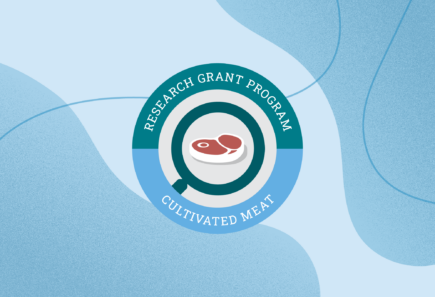
CulFish
Years active: 2023This project will produce an animal-free source of nutrients from upcycled waste streams for fish cells, enabling reductions in the cost of cultivated fish.

This project will produce an animal-free source of nutrients from upcycled waste streams for fish cells, enabling reductions in the cost of cultivated fish.

The Brodsky-Hanga collaboration will define an intracellular pathway in porcine muscle responsible for the uptake of glucose. The goal is to exploit this understanding to nourish cultured muscle cells for cultivated meat production.

This project aims to identify affordable plant albumins for culture media. Dr. Richards and his team will characterize at least six plant albumins that support fish cell growth.

Dr. Minic and his team will screen algal strains to produce extracts for cell media, focusing on albumin replacements. This project will produce inexpensive algal extracts with high potency to replace albumin in fetal bovine serum, significantly lowering media cost.

This project will develop novel edible and bioactive microcarriers for scalable, efficient, and reproducible cultivated fish production. These microcarriers will allow in vitro cultivation of fish embryonic stem cells and controlled delivery of essential molecules for cell growth.

Dr. Stogios’ project will uncover plant-based additives for cellular agriculture media. The team will determine whether transferrin, an expensive but key component of serum-free cell culture media, can be replaced by proteins from legumes (like beans, lentils or chickpeas).
Because alternative meat's fat content and fatty acid profile can be more easily controlled than conventional meat's, there is an opportunity to alter fat content for nutritional benefits. Additional research is needed to understand the sensory consequences of such manipulations, potentially allowing alternative meat producers to produce "nutritionally enhanced" products without compromising on sensory quality.
The cost and environmental impact of cultivated meat are driven by the cell culture media formulation and its conversion efficiency into meat. Metabolic modeling and engineering techniques can aid media formulation and ensure its optimal use. Targeted optimization will improve the cost-competitiveness and sustainability of cultivated meat production.
Efficient and cost-effective cultivated fish production will require precise optimization to encourage fast proliferation and highly efficient use of inputs while preventing premature differentiation. A variety of strategies can be employed to adjust various factors that contribute to these properties, including optimizing the starting cell line, improving the composition of the proliferation medium, and exploring the possibility of transdifferentiating easy-to-grow cell lines like fibroblasts into myogenic and adipogenic lineages.
Meticulous attention to sterility controls throughout cultivated meat production is essential to optimize food safety, but the cost of biopharmaceutical-based sterility—the current standard for cell-based processes—is incongruent with large-scale food production. Research to identify alternative sterility processes with lower costs is needed for cultivated meat to scale successfully.